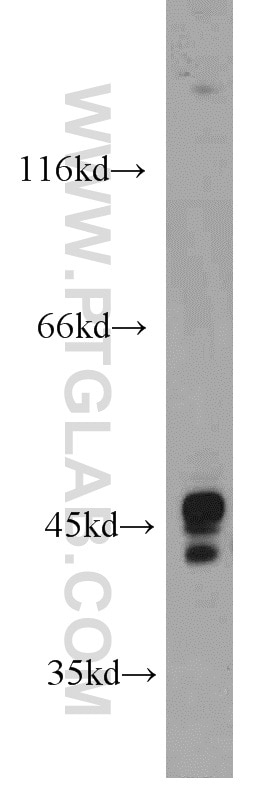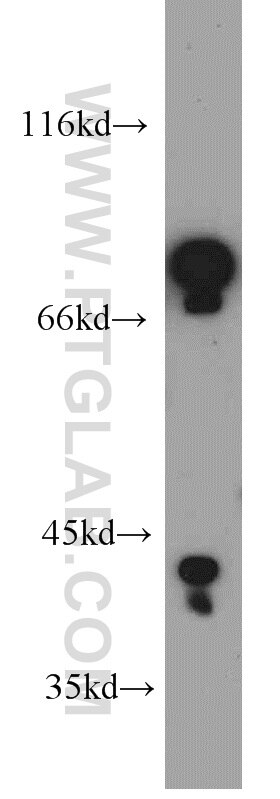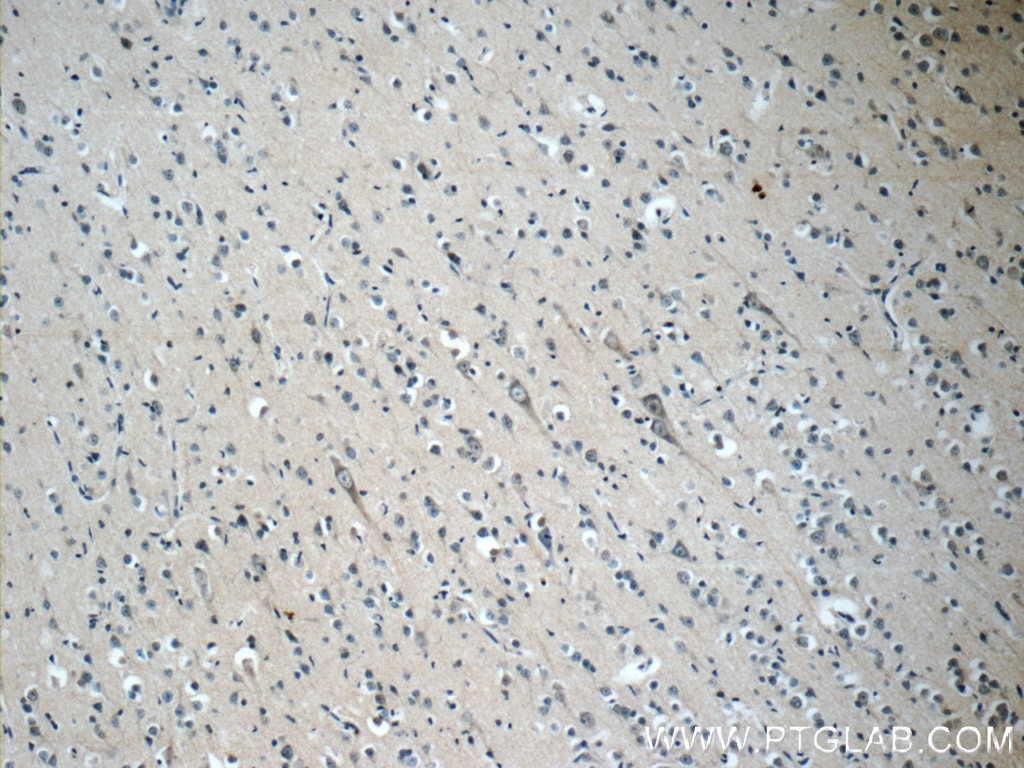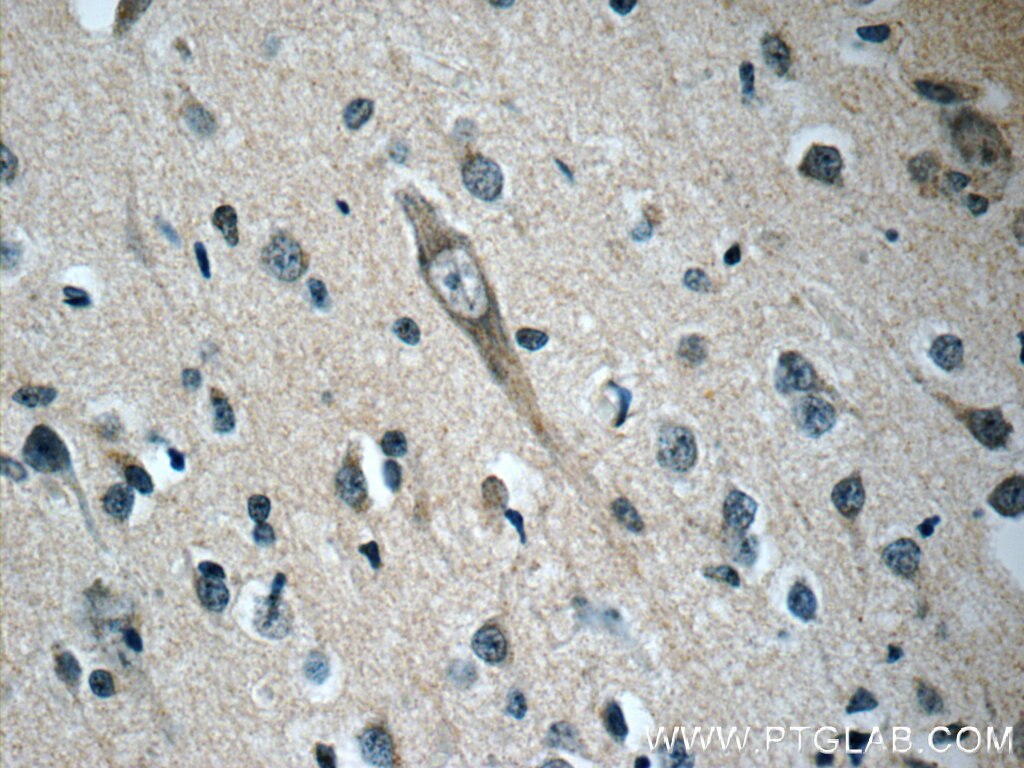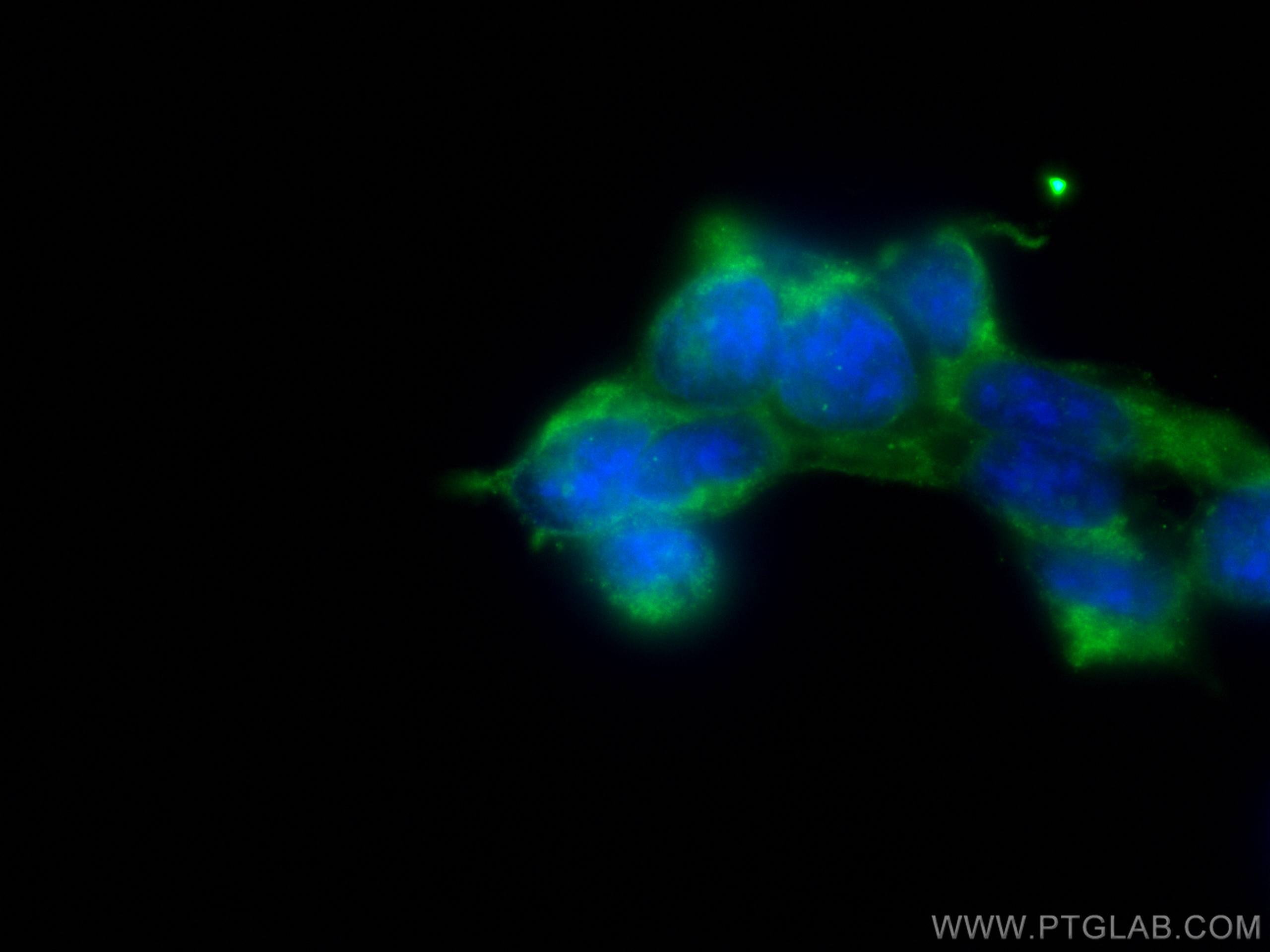OFD1 Polyklonaler Antikörper
OFD1 Polyklonal Antikörper für IF, IHC, WB, ELISA
Wirt / Isotyp
Kaninchen / IgG
Getestete Reaktivität
human und mehr (3)
Anwendung
WB, IHC, IF, ELISA
Konjugation
Unkonjugiert
Kat-Nr. : 22851-1-AP
Synonyme
Galerie der Validierungsdaten
Geprüfte Anwendungen
| Erfolgreiche Detektion in WB | HeLa-Zellen, SH-SY5Y-Zellen |
| Erfolgreiche Detektion in IHC | humanes Hirngewebe Hinweis: Antigendemaskierung mit TE-Puffer pH 9,0 empfohlen. (*) Wahlweise kann die Antigendemaskierung auch mit Citratpuffer pH 6,0 erfolgen. |
| Erfolgreiche Detektion in IF | HEK-293-Zellen |
Empfohlene Verdünnung
| Anwendung | Verdünnung |
|---|---|
| Western Blot (WB) | WB : 1:500-1:1000 |
| Immunhistochemie (IHC) | IHC : 1:20-1:200 |
| Immunfluoreszenz (IF) | IF : 1:50-1:500 |
| It is recommended that this reagent should be titrated in each testing system to obtain optimal results. | |
| Sample-dependent, check data in validation data gallery | |
Veröffentlichte Anwendungen
| WB | See 4 publications below |
| IF | See 4 publications below |
Produktinformation
22851-1-AP bindet in WB, IHC, IF, ELISA OFD1 und zeigt Reaktivität mit human
| Getestete Reaktivität | human |
| In Publikationen genannte Reaktivität | human, Maus, Ratte, Zebrafisch |
| Wirt / Isotyp | Kaninchen / IgG |
| Klonalität | Polyklonal |
| Typ | Antikörper |
| Immunogen | OFD1 fusion protein Ag18898 |
| Vollständiger Name | oral-facial-digital syndrome 1 |
| Berechnetes Molekulargewicht | 1012 aa, 117 kDa |
| Beobachtetes Molekulargewicht | 43 kDa, 120 kDa |
| GenBank-Zugangsnummer | BC096344 |
| Gene symbol | OFD1 |
| Gene ID (NCBI) | 8481 |
| Konjugation | Unkonjugiert |
| Form | Liquid |
| Reinigungsmethode | Antigen-Affinitätsreinigung |
| Lagerungspuffer | PBS mit 0.02% Natriumazid und 50% Glycerin pH 7.3. |
| Lagerungsbedingungen | Bei -20°C lagern. Nach dem Versand ein Jahr lang stabil Aliquotieren ist bei -20oC Lagerung nicht notwendig. 20ul Größen enthalten 0,1% BSA. |
Hintergrundinformationen
OFD1, also named CXorf5 and 71-7A, belongs to the OFD1 family. It has been implicated in several developmental syndromes, including a male-lethal X-linked dominant condition, Oral-Facial-Digital type 1 (OFD1) syndrome, X-linked recessiveSimpson-Golabi-Behmel syndrome type 2 (SGBS2), and Joubert syndrome and related disorders (JSRDs). It is a component of the centrioles controlling mother and daughter centrioles' length. It recruits to the centriole IFT88 and centriole distal appendage-specific proteins including CEP164. Involved in the biogenesis of the cilium, a centriole-associated function. OFD1 plays an important role in development by regulating Wnt signaling and the specification of the left-right axis. This antibody recognizes all the isoforms of OFD1. The 43 kDa is isoform 2. The ~80 kDa band is unknown.
Protokolle
| Produktspezifische Protokolle | |
|---|---|
| WB protocol for OFD1 antibody 22851-1-AP | Protokoll herunterladen |
| IHC protocol for OFD1 antibody 22851-1-AP | Protokoll herunterladen |
| IF protocol for OFD1 antibody 22851-1-AP | Protokoll herunterladen |
| Standard-Protokolle | |
|---|---|
| Klicken Sie hier, um unsere Standardprotokolle anzuzeigen |
Publikationen
| Species | Application | Title |
|---|---|---|
Nat Commun Coupling bimolecular PARylation biosensors with genetic screens to identify PARylation targets. | ||
PLoS Biol Acute inhibition of centriolar satellite function and positioning reveals their functions at the primary cilium. | ||
Biochem Biophys Res Commun BIX-01294-induced autophagy regulates elongation of primary cilia. | ||
Oncol Lett Abnormal accumulation of OFD1 in endometrial cancer with poor prognosis inhibits ciliogenesis. | ||
Cell Biosci IK is essentially involved in ciliogenesis as an upstream regulator of oral-facial-digital syndrome ciliopathy gene, ofd1 |
Rezensionen
The reviews below have been submitted by verified Proteintech customers who received an incentive forproviding their feedback.
FH Elisa (Verified Customer) (06-15-2022) | HEK293 cells stained for Hoechst (DNA marker, in green), OFD1 (mother centriole distal appendage marker, in magenta) and PCNT (pericentriolar matrix marker, in green). HEK293 cells were plated on Poly-lysine coated coverslips and fixed in cold methanol for 2' at -20C. Cells were then rehydrated with PBS for 5'. Membrane permeabilization was then performed with 0.1% Triton + 0.1% Tween +0.01%SDS in PBS for 5'. Cells were finally incubated with blocking buffer (5% BSA+ 0.1% Tween in PBS) for 30' at RT. Primary antibody was diluted in blocking buffer 1:200 and incubated for 1h at room temperature. Alexa-555-Anti-rabbit was used as secondary antibody (1:600 dilution) (1h at room temperature). OFD1 recognises mother centriole.
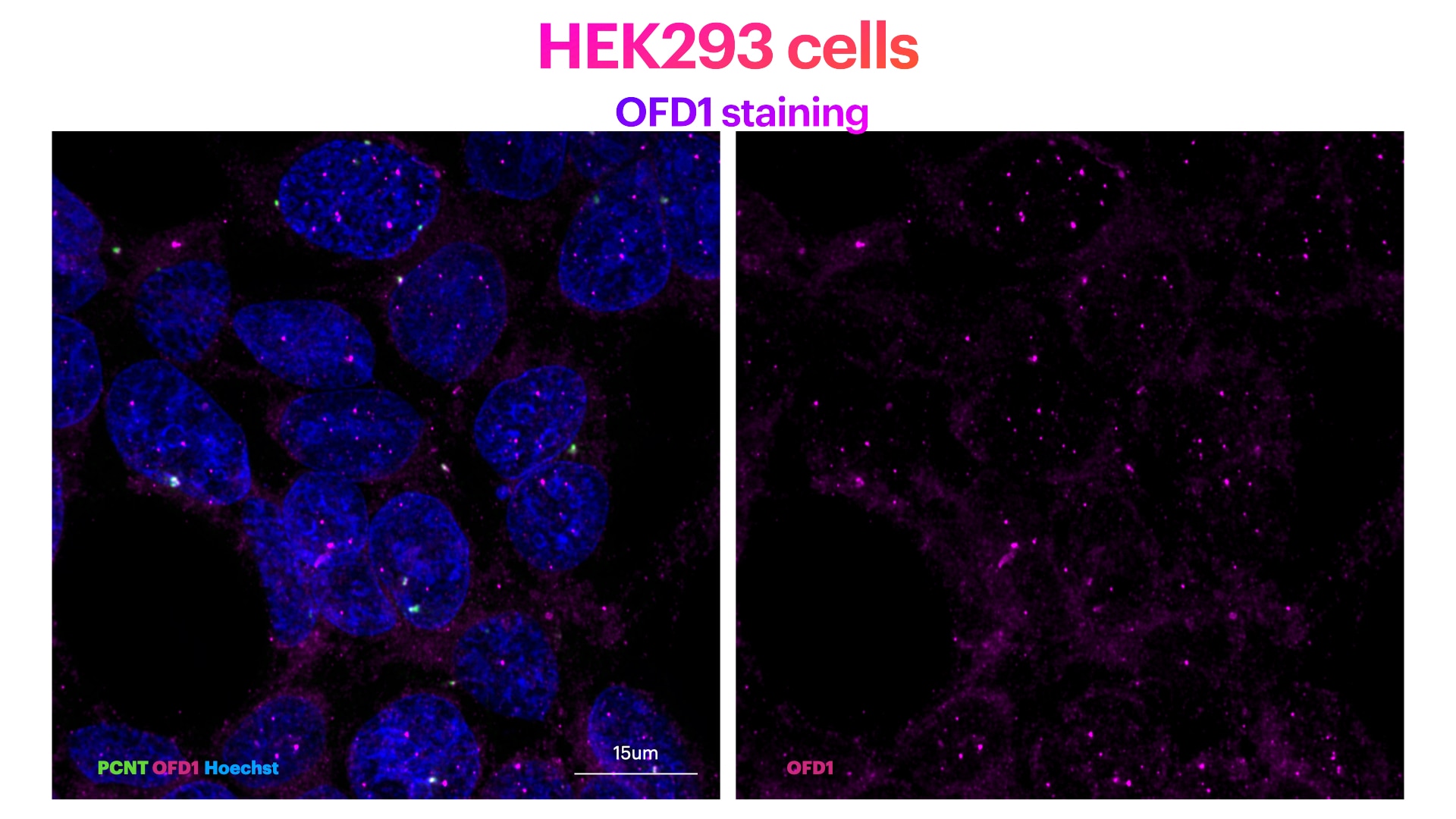 |
FH Sarah (Verified Customer) (02-16-2021) | Works very well for detection of OFD1 in HEK 293T cells
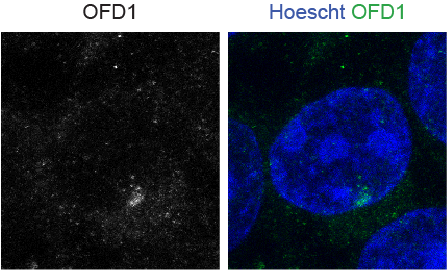 |
